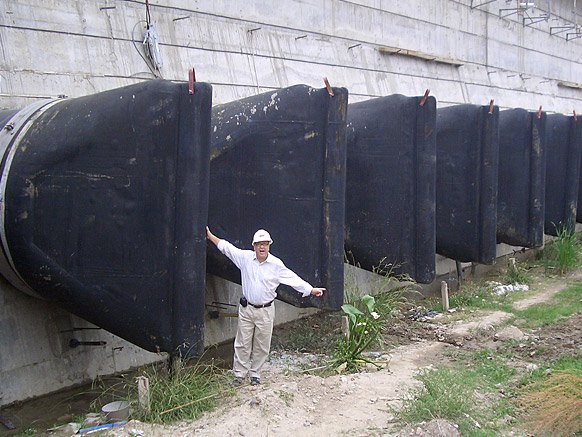There’s a story behind this older post. Bit long, but might be fun if you have nothing else going on.

Our place in O’Fallon was in the unincorporated county area, which means it’s a hit or miss what kind of service you get. Originally, the homes in the subdivision had septic tanks, but our plot couldn’t be developed until there was a sewer line, because of the steep hill in back.
When the O’Fallon gravity line was added, our house was barely in range, and they took the lateral sewer line to the manhole, and terminated it in the manhole.
Now, terminating a lateral sewer line in a manhole is a bit of a no-no, but since we were at the start of the line, they thought it would be OK.
The problem is, Lake St. Louis, next door, grew too fast and there were issues with its sewer. So they drilled a _force_ main from Lake St. Louis and terminated it at the manhole for our gravity main.
This is engineering insanity, and actually illegal in most of the country. But such is the quality of sewer management in St. Charles county, Missouri.
What would happen is every time it rained over a certain amount, typically about 1 1/2 inches to 2 inches in a 24 hour period, the water seeping into the force main would overwhelm the man hole and would force the flow back to the next outlet.
Our house.
So when it rained, we couldn’t use our toilets, and if it rained enough, raw sewage would back up into our shower and bath.
I was polite about complaints at first, but then got tired. So, every time this would happen, I would call O’Fallon and tell them we had a sewage backup. They’re required by law to come out to check it out, and it also gets recorded as a sewage backup for the environmental powers that be.
I wasn’t a squeaky wheel…I was a full out bitch. There wasn’t anyone in the sanitation department of two different systems that I didn’t contact by email, or in person.
Water District 2 (force main) blew me off, but O’Fallon took it seriously. The assistant supervisor explored options everywhere for what they could use to protect our lateral sewer line.
In the end, they had the company that developed the check valves you see here, develop a custom made one just for the end of our lateral line in the manhole.
When they installed it, the force main was shut down temporarily and two crews came out: one for the manhole to install the device, and one further down to send fresh air into the manhole.
It installed in about 10 minutes. That was it. And it worked beautifully.
From then on, no matter how much rain, no backup. And we could continue using our toilets, since even when the valve closes, it could still expel liquids out.
When we sold the house, the day before closing, we stayed in a hotel because everything was packed up. That night was one hell of a storm—over 5 inches of rain fell. When we got to the house, the sanitation crew was out washing down our neighbor’s yard because the sewage had overflowed into their yard. It was a mess.
The neighbor across the street came over and said for the first time, they had backup into their house and into their washing machine in the basement. He knew about our previous problems, and he and a couple of other neighbors thought our place would be destroyed by the sewage, and right before closing.
Nope. Not a drop. Clean as a whistle.
These things look simple. No whirring lights, no gadgetry, just plain rubber. But they are brilliant.
And if your wheels don’t squeak nothing good will happen.
